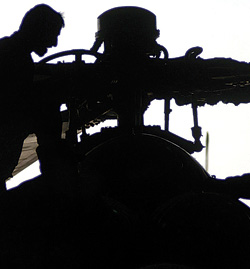INDIAN ARMED FORCES CHIEFS ON OUR RELENTLESS AND FOCUSED PUBLISHING EFFORTS

The insightful articles, inspiring narrations and analytical perspectives presented by the Editorial Team, establish an alluring connect with the reader. My compliments and best wishes to SP Guide Publications.

"Over the past 60 years, the growth of SP Guide Publications has mirrored the rising stature of Indian Navy. Its well-researched and informative magazines on Defence and Aerospace sector have served to shape an educated opinion of our military personnel, policy makers and the public alike. I wish SP's Publication team continued success, fair winds and following seas in all future endeavour!"

Since, its inception in 1964, SP Guide Publications has consistently demonstrated commitment to high-quality journalism in the aerospace and defence sectors, earning a well-deserved reputation as Asia's largest media house in this domain. I wish SP Guide Publications continued success in its pursuit of excellence.
- Appointments Committee of Cabinet approves one-month extension in service of Chief of the Army Staff
- Admiral Dinesh K. Tripathi assumes Command of the Indian Navy as 26th Chief of the Naval Staff
- Prime Minister witnesses 'Bharat Shakti' – a Tri-Services Firing and Manoeuvre Exercise in Pokhran, Rajasthan
- Interim Defence Budget 2024-25 — An Analysis
- Union Defence budget 2024
- Prime Minister Modi Commemorates Indian Navy Day in a Grand Ceremony
End of a turf war?

Unfortunately, despite several organisational and doctrinal changes to promote jointmanship as also considerable rhetoric emanating from the highest echelons of the two services, the required degree of integration between the Indian Army and the IAF has not been achieved
On October 13, 2012, after prolonged dithering, the government finally decided to accept the plea from the Indian Army that it should have its own fleet of attack helicopters which so far has been under the control of the Indian Air Force (IAF). While one report says that “the Defence Ministry has decided that all future acquisitions of the attack helicopters would be for the Army”, sources in the IAF maintain that the letter from the Ministry of Defence referred to “all the future acquisitions only”, not the existing ones thus excluding the 22 AH-64D Apache attack helicopters that are being procured by the IAF. Thus along with the Apache fleet, the IAF will continue to operate the two squadrons of the Russianorigin Mi-25/35 attack helicopters and the medium-lift Mi-17 V5 helicopters. Under the existing arrangement, though maintained and manned by the IAF, the fleet of attack helicopters is under the operational control of the Indian Army. This arrangement does not quite meet the requirements of the Indian Army.
It is expected that this decision by the government would bring to an end at least one of the contentious issues between the Indian Army and the IAF. The timing of the decision however is somewhat unique in some ways as it comes at a time when the IAF was just about recovering from the euphoria of its 80th anniversary celebrations as also soon after a statement to the media by Air Chief Marshal N.A.K. Browne, Chief of the Air Staff, that “it was not possible to have little air forces”.
While the decision undoubtedly would raise the spirits in the Indian Army, it would definitely be somewhat disconcerting for the IAF. But what must have been most odd and galling for the leadership in the IAF is the report that “The National Security Advisor had to intervene on behalf of Defence Minister A.K. Antony” to solve what the latter described as a ‘family problem’. Involvement of an outside agency to mediate in a dispute between the Indian Army and the IAF, apart from being somewhat incongruous, is likely to set a precedent that may not be a healthy one for the Indian armed forces in the long-term perspective.
Viewed dispassionately, the Indian Army’s case for having its own fleet of attack helicopters is not devoid of logic. In a fast moving battle fought in a network-centric environment with large armoured forces deployed, intimate, swift and accurate firepower delivered by airborne platforms would be critical to success. Unfortunately, despite several organisational and doctrinal changes to promote jointmanship as also considerable rhetoric emanating from the highest echelons of the two services, the required degree of integration between the Indian Army and the IAF has not been achieved. Hence the single-minded pursuit by the Indian Army to have its own attack helicopters rather than depend on the IAF. The Indian Army badly needs to cut down the time taken to mobilise their strike corps, an essential pre-requisite for the newly introduced Cold Start Doctrine. The land forces would also need swift response by attack helicopters as also a high degree of flexibility to cope with rapidly changing tactical situations. As per the Indian Army, it would be difficult, if not impossible, to ensure these without fully integrating the attack helicopters with the land forces.
The Army Aviation branch was created in 1986 with the erstwhile Air Observation Post units owned by the IAF, being transferred to the Army. Subsequently, the Indian Army acquired its fleet of light utility helicopters by way of Cheetahs and Chetaks, the latter even converted for limited attack role. The weight limit of five tonnes then defined has now been lifted consequent to the recent decision on attack helicopters. Thus there has been a sustained effort by the Indian Army to ensure a progressive growth of integral air power. It is only a matter of time before there is a renewed effort at acquiring light transport aircraft as well, a move that the IAF is likely to vehemently oppose. The recent decision by the government is, therefore, unlikely to bring an end to the turf war.





